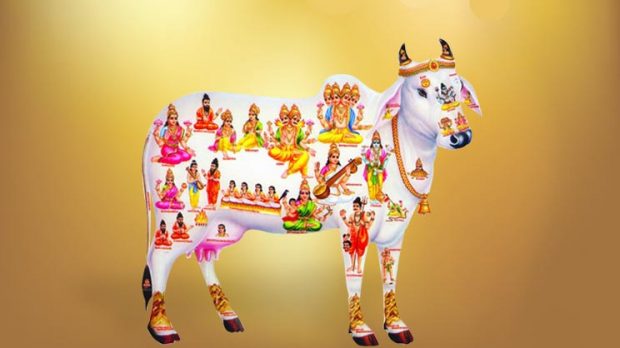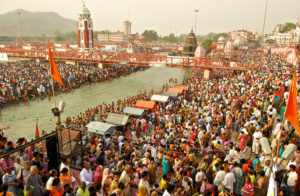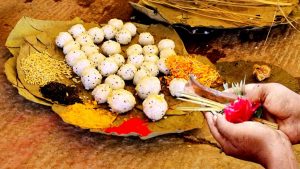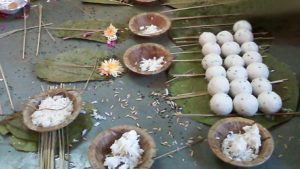GO-SAMRAKSHANA was established with the sole intention of protecting and preserving the cows. According to Hindu Dharma, one is ordained to worship and feed cows every day. But today, thinking of the welfare of the poor and disabled cows is also being considered by many as worship. It is all the more meaningful for an individual to support and help “Go Sewa” kendras that are constantly endeavouring to protect cows from butchers and to save poor and old cows by providing them peaceful lives.
Namo devyai Maha devyai
Surabyai cha namo nama.
Gavam Bheeja swaroopaya,
Namasthe Jagad Ambike.
Meaning:
Salutations to the mother of the world, who lives as a seed in all cows, Salutations to that goddess, Who is a great goddess, And who is the wish yielding cow.
It needs a helping hand from each one of us. Taking care of cows is more difficult than taking care of human beings.
Once, a divine person said, “Go Himsa ends at slaughter houses but Himsa actually starts at farmer places.” Cow protection begins from Farmers. They should realise Cow is actually protecting them and without realising this, they should not leave them like orphan when milk yielding is stopped”
Why do we need to protect Cows?
The cow is worshipped as Kamadhenu and is a symbol of prosperity and wealth. People worship Goddess Lakshmi in the form of a cow. Since there is a motherly association, the cow is known as Gomatha. A human mother nurtures her infant alone, but Gomatha nurtures all living beings on earth. She is also called JAGAN MATHA (Mother of Universe) because that is the extent of her generosity. The milk of a cow has sattvic or purifying qualities. Ghee from cow’s milk is used in ceremonies and in preparing religious food. Cow dung is used as fertiliser, as a fuel and as a disinfectant in homes. The Supreme purificatory material, panchagavya, was a mixture of five products of the cow, namely milk, curd, ghee, urine and dung. There is nothing that is more sacred or sanctifying than cows. These kind animals serve mankind in many forms and ways right from its birth till its end. The punya karma of Go Samrakshana is carried to about seven generations. It is highlighted in the scriptures.

Which part of the COW is sacred?
Kamadhenu’s complexion is white, like the clouds. Every part of the cow’s body has religious significance. Its legs symbolise the four Vedas, its teats the four Purusharthas, its horns symbolise gods, its face symbolises the sun and the moon and its shoulders Agni.
“SARVE DEVAAH STHITA DEHE SARVA DEVAMAYEEHI GAOU”
The shloka means that all the deities dwell in the body of a cow. Therefore the cow itself is as holier, as the deities. The cow symbolises the dharma itself. It is said to have stood steadily upon the earth with its four feet during the Satyug (world’s first age of truth), upon three feet during the Tretayug (the second stage of less than perfection), upon two feet during theDwaparyug (the third stage of dwindling and disappearing perfection) and only on one leg during Kaliyug (the fourth and current age of decadence)
The name for a cow in the Vedas is known as ASAGHYNA which means inviolable.
Another name is “ahi,” which means not to be killed and another is “aditi” which means never to be cut into pieces.
“Why people respect and protect these remarkable COWS?”
Mahatma Gandhi once said, “One can measure the greatness of a nation and its moral progress by the way it treats its animals. Cow protection to me is not mere protection of the cow. It means protection of all that lives and is helpless and weak in the world. The cow means the entire subhuman world.”
After all Cow is just another animal. Then, what is so particular about Cows?
In the Sanathana Dharma, the cow symbolises all other creatures. The cow is a symbol of the Earth, the nourisher, the ever-giving, undemanding provider. The cow represents life and the sustenance of life. The cow is so generous, taking nothing but water, grass and grain. It gives and gives and gives off its milk, as does the liberated soul give of his spiritual knowledge.
Why do people worship the Cow?
All the parts of the Cow denote 33 Divine Energies as per our Sanathana Dharma
| | |
| 1. Right Eye | |
| | |
| | |
| | |
| | |
| | | Kubera – The lord of North & Wealth | |
| 7. Right Horn | |
| | |
| | |
| | |
| | | Saraswathi – Goddess of Wisdom & Speech | |
| | | Vageeshwari – The vocal Speech | |
| | | NakuliVageeshwari – Subtle Speech | |
| | | Bhairav – Time as witness | |
| | |
| | |
| | |
| | |
| | |
| | |
| | | Bhoodevi – Goddess of Earth | |
| | | Amrithasagar (Ocean of Immortality) | |
| 23. Above Udder Hierarchy | | | (Kumaras, Seven Seers and Naradha) | |
| | |
| | | Sridevi – Goddess of Wealth | |
| | | The celestial sacred waters (Rivers) | |
| | |
| | |
| | |
| | | From South Pole Heel to Ankle | |
| | | From North Pole Heel to Ankle | |
| 32. Teats Front Right Front Left Back Right Back Left | | | Rig Veda Yajur Veda Sama Veda Atharvana Veda | |
| 33. Four Hooves Front Right Front Left Back Right Back Left | | | Existence Awareness Thought Action | |
How do you say Cow is considered as a good deed and brings happiness to all?
In the Vedas, cows represent wealth and joyous Earthly life. The Rig Veda (4.28.1;6) says. “The cows have come and have brought us good fortune. In our stalls, contented, may they stay! May they bring forth calves for us, many-colored, giving milk for Indra each day. You make, O cows, the thin man sleek; to the unlovely you bring beauty. Rejoice our homestead with pleasant lowing. In our assemblies, we laud your vigour”.
Why do we appeal to support on the Go Matha Protection?
Lord Krishna states in Srimad Bhagavad-Gita: chapter 10, verse 28
“DHENUNAM ASMI KAMADHUK DHENUNAM”
“One who gives in charity a bull becomes famous even in Swarga.”- The Mahabharata
“One who donates a cow (or bull) becomes free from sin and achieves liberation for himself and 14 generations of his family members”. – The Mahabharata
“The cows are the mothers of all living beings and the givers of all earthly pleasures.” – Atharvana Veda








